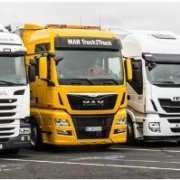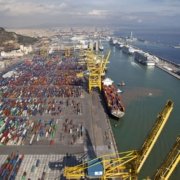A Spotlight on Hydrogen Fuel Cells

Written by: Lidia Slawinska, Digital Communications
Over the past decade hydrogen has really taken centre stage in the search for an alternative fuel for maritime transport. Different applications of the gas have been researched and trialled in various maritime scenarios. The most recent and most successful case in recent years, without a doubt, has been the development and implementation of hydrogen fuel cells. In this #DidYouKnow article we take a look at this technology and consider its impact on the maritime industry.
Hydrogen Fuel Cells
Fuel cell technology has been around since the early 1800s. A fuel cell is an “electrochemical energy conversion device that was invented in 1839 by William Grove to produce electricity by combining hydrogen and oxygen into water” (GenCell Energy). Like regular batteries, fuel cell batteries can convert potential energy into electricity, and result in heat as a by-product. In the 1950s, in the heart of the Cold War arms and space races that took place between the USA and USSR, liquid hydrogen was explored as a powerful fuel and finally used to send rockets into space – taking it one step closer towards the hydrogen fuel cell.
In recent years this technology has been considered for freight transport journeys. As more and more research is being done on different sustainable alternatives to fossil fuels, fuel cell technology took centre stage. Using the example of green hydrogen to power ships, researches have adapted Grove’s traditional concept to be able to use hydrogen’s energy and convert it to electricity and heat, and therewith power the vessels’ propulsion mechanisms. In other words, hydrogen fuel cells combine hydrogen with oxygen, and therewith produce electricity. The hydrogen is sourced from a tank that is built into the cell, where it then reacts with oxygen that is “sourced” from air. The resulting chemical reaction produces electricity, water and heat. The water and heat are released as water vapours, and thus are considered zero-emission by-products.
The electricity provides continuous energy to the ships as long as the cell is fed with the “fuel” – in this case hydrogen gas. This proves to be an advantage over conventional electric batteries that have a fixed shelf-life or need recharging . Fuel cells generate very little noise pollution, can easily be modified for different-sized vessels, and have no distinct moving parts. There is a general consensus that the vast majority of vessels could easily be retro-fitted with this technology – therewith lowering the carbon footprint of the shipping industry.
Hydrogen Sourcing
It is not difficult to understand why scientists are excited about such capabilities of hydrogen – as it is the most abundant element on our planet. However, it is rare to find it in its isolated form. It can found in water and other hydrocarbon chemical elements such as methane. In order for it to be used in hydrogen fuel cells, the element needs to first be isolated through chemical, biological or solar-driven processes. (An interesting side-note is that nearly 85% of hydrogen is already being produced daily in fossil fuel refineries during the processes of removing sulphur from gasoline).
There are sustainable sourcing solutions utilised by some companies in the world. Hydrogen can be produced using biogas, or through electrolysis that uses electricity generated by solar or wind power. Relying on such sourcing alternatives will help keep CO2 emissions low from the entire hydrogen fuel operation in the transport sector.
Sustainable Shipping
One kilogram of hydrogen has the same energy density as a gallon of diesel.
At the end of the noughts, the European Commission began to direct its policies more actively towards sustainable transport amid growing concerns related to climate change. In the 2008 European Strategic Energy Technology Plan, hydrogen and fuel cells were singled out as the new technologies that would help the transport sector achieve a 60-80% reduction in GHG by the middle of the century.
Because hydrogen fuel cells already exist, and don’t require a huge investment of shipowners to install them in vessels, they are being considered as a fore-runner in the field. William Alan Reinsch, Scholl Chair in International Business estimates that “hydrogen fuel could replace 43 percent of voyages between the United States and China without any changes, and 99 percent of voyages with minor changes to fuel capacity or operations.”
Currently there is already one hydrogen powered ship – the Energy Observer – carrying out a six-year trip around the world. In its virgin voyage, the ship uses solar panels, wind and wave turbines to power the process. Its success coud determine whether the method could prove efficient and effective for various ocean voyages.
Challenges to Hydrogen
It wouldn’t be prudent to assume that hydrogen was the faultless solution that would eliminate all GHG within the shipping industry – as it has some challenges and complications. Hydrogen gas is extremely flammable, and its chemical properties mean that it can burn at both low and high concentrations when combined with oxygen in an uncontrolled reaction. Shipowners need to make sure that important safety measures are in place to lower the risk of such explosions during their transport and storage.
An added complication that would need to be addressed is that the element (even in its liquid form) is very energy dense. This means that the fuel cells themselves take up more volume on larger vessels – potentially lowering the profitability of the voyages themselves for ship owners (with diminished cargo spaces on the vessels themselves).
Finally, the cost of the type of hydrogen sources is also important to take into account. Hydrogen Fuel Cells use so-called “Green Hydrogen” (there are three types – Gray, Blue and Green, with Green being touted as the most ecologically sourced) – which currently is the most expensive hydrogen available on the market. For the shipping industry to be truly sustainable, this is the hydrogen type that would need to be used, and therefore its costs would need to be adjusted to make it appealing to the private sector.
A Greener Future
There is no doubt that the path ahead for the shipping industry is difficult and full of unknowns. There is no one-answer-fits-all solution to try to eliminate GHG emission from the oceanic trades. Different solutions are currently being tested and are being developed at astonishing rates. More than one would need to exist for the goals set by the IMO for 2050 to be reached.
Hydrogen Fuel Cells are proving to be very effective and, if embraced by the shipping industry, could prove integral towards the goal of zero emissions maritime transport. Even though no giant vessels have embraced the technology, smaller ferries and ships have begun operating in the USA, France, Norway and Belgium. Moreover, “oil major Royal Dutch Shell has invested in several hydrogen production projects in Europe and China, arguing that hydrogen is “advantaged over other potential zero-emissions fuels for shipping,” as attested by William Alan Reinsch – a huge sign that even the traditional fuel sourcing companies are coming on board.
There is still a long road ahead, but with the continuous innovations from scientists and financial contributions from big players in the industry, the goal of achieving global net zero emissions by 2050 could, perhaps, be attainable. Hydrogen fuel cells could be responsible for a significant step in that direction.
Sources









